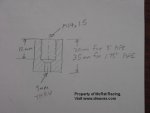testNobody ever accused me of being a fast learner! 
Seems there are 4 basic kinds of sensors that affect me:
Thermocouple pyrometers. These generate voltage based on how hot they get, but only generate millivolts, or thousanths of a volt. You need an amplifier that is normally built into the gauge to read it.
12v supplied, 1-5v output. This means the voltage goes from 1 to 5 depending on what is happening to the sensor. Most of these have circuits in them to control the supply voltage so it doesn't affect the readings. Your car will make 12.5 to 14.7v depending on what it's doing, and most these sensors can go 10-24v or more before accuracy is harmed.
5v supplied, 0.5-4.5v output. These are sensors in our trucks. They need a fairly stable voltage to work according to the datasheet that comes with the sensor. Our ECM provides this stable voltage at ~5.08v
Now the last kind is 4-20 milliamp. They do not have a power lead, and are basically variable resistors. It appears the the LMM Pyro sensor is one of these. Ohm's Law is I = V / R , or amps equals volts divided by resistance. So at room temp, it's 20 milliamps, and at high temp it's 4 milliamps.
It is this last kind that is driving me nuts. The LMM pyro appears to be one of these. I can use a "voltage divider" circuit on it, and feed it 12v, and get 0-5v out of it, but the range of voltage sucks. I want the maximum "sweep" I can get between .5 and 4.5v, but I can only get 2.5v.
There must be some kind of circuit they use with these get the full sweep, but I can't find it.
Seems there are 4 basic kinds of sensors that affect me:
Thermocouple pyrometers. These generate voltage based on how hot they get, but only generate millivolts, or thousanths of a volt. You need an amplifier that is normally built into the gauge to read it.
12v supplied, 1-5v output. This means the voltage goes from 1 to 5 depending on what is happening to the sensor. Most of these have circuits in them to control the supply voltage so it doesn't affect the readings. Your car will make 12.5 to 14.7v depending on what it's doing, and most these sensors can go 10-24v or more before accuracy is harmed.
5v supplied, 0.5-4.5v output. These are sensors in our trucks. They need a fairly stable voltage to work according to the datasheet that comes with the sensor. Our ECM provides this stable voltage at ~5.08v
Now the last kind is 4-20 milliamp. They do not have a power lead, and are basically variable resistors. It appears the the LMM Pyro sensor is one of these. Ohm's Law is I = V / R , or amps equals volts divided by resistance. So at room temp, it's 20 milliamps, and at high temp it's 4 milliamps.
It is this last kind that is driving me nuts. The LMM pyro appears to be one of these. I can use a "voltage divider" circuit on it, and feed it 12v, and get 0-5v out of it, but the range of voltage sucks. I want the maximum "sweep" I can get between .5 and 4.5v, but I can only get 2.5v.
There must be some kind of circuit they use with these get the full sweep, but I can't find it.



